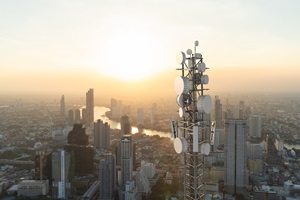As consumer demand rises, and network availability expands, 5G is becoming more viable for widespread use by 2027 it’s expected to cover 75% of the world’s population. However, it’s still no secret that 5G uptake is dawdling and many enterprises still aren’t enjoying its benefits. Here, Hamish White, CEO and founder of telecoms consultancy and software provider Mobilise, explores what’s required to make enterprise 5G use cases a widespread reality.
In contrast to previous generations, 5G can be split into three separate use cases, each with different qualities that favour different connectivity qualities Enhanced Mobile Broadband (eMBB), Ultra-Reliable and Low Latency Communications (URLLC) and massive Machine-Type Communication (mMTC). eMBB, as its name suggests, builds on connectivity capabilities already fulfilled by 4G, typically mobile connectivity for consumer telecoms applications, while URLLC and mMTC are new use cases that haven’t been possible before 5G’s arrival.
New generation of use cases
While eMBB offers businesses greater agility and broader, faster download speeds, the true value of 5G lies in URLLC and mMTC use cases. URLLC caters to latency-sensitive connected devices that need extremely reliable real-time data transfer for success, and is useful for machine-to-machine (M2M) communication. M2M comms is becoming increasingly popular in smart factories, which use real-time connectivity to enable robotic process automation, autonomous vehicle networks and even augmented reality (AR) scenarios.
mMTC, on the other hand, unlocks the potential of 5G for Internet of Things (IoT) deployment, as it can connect up to one million devices per square kilometre. IoT deployments have traditionally been limited by 4G’s limited capacity to do this, but 5G mMTC has over ten times the capacity of 4G for IoT. This makes the possibility of connecting devices for smart cities much more feasible, providing the infrastructure to connect traffic systems, refuse collection and electricity distribution to an overarching city-wide network.
Although network operators are currently working to build the required infrastructure to support all of 5G, the current set up doesn’t facilitate widespread access to each of these use cases.
Going private
One approach for enterprises looking to unlock 5G’s full benefits is to develop their own, private 5G network. Almost all of the public 5G network uses some of the existing 4G infrastructure, namely the 4G long-term evolution (LTE) core. While this approach unlocks some 5G capabilities, a private 5G network with a 5G core is essential to enabling some elements of URLLC and widespread mMTC use cases.
Private networks are completely built, managed and maintained by enterprises themselves. The network is exclusively used by enterprise-authorised devices within a defined location for exclusive use by the enterprise. This offers absolute control of where connectivity is available and unparalleled security, with no responsibility lying with external service providers and no concern around potential interference from other public network users.
However, private 5G networks are localised the network’s only available within the area where the enterprise has deployed it, limiting its use to only within a localised area. Additionally, there are some regulatory concerns around 5G private networks. To access certain bandwidths of the 5G spectrum, businesses may find it necessary to work with a network operator or obtain a government license to use spectrum in a given location.
Taking a slice
Alternatively, service providers (SPs) can use network slicing to allocate portions of the 5G network, and certain features, to enterprise customers. Each network ‘slice’ is uniquely customised to each customer’s requirements be it massive bandwidth, ultralow latency or large device density to enable the use cases each enterprise wants to develop.
Network slicing has been heavily invested in by huge vendors including Ericsson and Nokia and offers many benefits for enterprises striving for 5G success. Acquiring just a portion of a carrier’s network means that an enterprise customer’s dedicated network is supported by existing mobile infrastructure enterprises don’t have to deal with the logistics or cost implications of setting up their own network.
Additionally, relying on existing carrier infrastructure means there’s no geographical barriers to the ‘slice’, it’s available everywhere that the telecoms network already exists. Enterprises can connect devices from anywhere within the range of the network, not just from within the boundaries of one facility or premise.
Within telecoms itself, network slicing is widely becoming recognised as a source of great business potential, with Ericsson estimating its worth to reach $200 million USD by 2030. However, network slicing will require network operators to deploy 5G cores across the public network to facilitate the complete set of use cases possible.

Be it private networks, network slicing or general 5G deployment, Mobilise helps SPs and businesses to better understand the enterprise telecoms landscape, including IoT capabilities through its mobile strategy services. With unrivalled experience in 5G implementation strategy development, Mobilise’s 5GTM framework offers a modular suite of end-to-end support services that help operators to smoothly transition from 4G to 5G, build a new infrastructure including RAN, OSS and BSS, as well as solutions on how best to maximise the benefits of data, analytics and AI.
While some argue that network slicing and private networks are competitors in the quest for en masse 5G adoption, in reality, they actually complement each other. Both have a place in supporting businesses to launch their own 5G-enabled use cases and should both be considered for ultimate, widespread 5G success.
The author is Hamish White, CEO and founder of telecoms consultancy and software provider Mobilise.
Comment on this article below or via Twitter: @VanillaPlus OR @jcvplus






